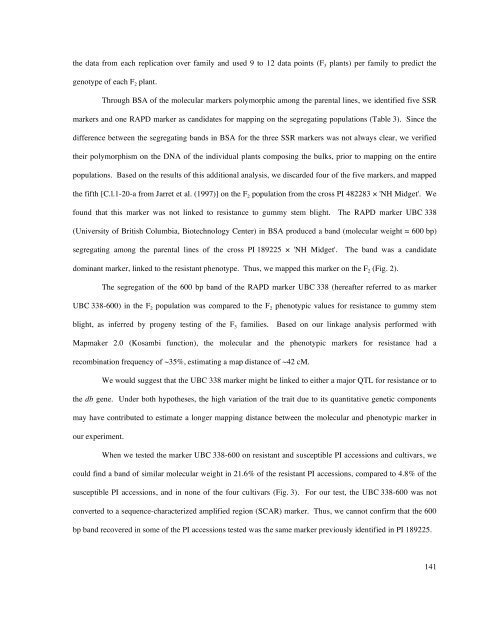Citrullus lanatus (Thunb.) Matsum. & Nakai - Cucurbit Breeding ...
Citrullus lanatus (Thunb.) Matsum. & Nakai - Cucurbit Breeding ...
Citrullus lanatus (Thunb.) Matsum. & Nakai - Cucurbit Breeding ...
Create successful ePaper yourself
Turn your PDF publications into a flip-book with our unique Google optimized e-Paper software.
the data from each replication over family and used 9 to 12 data points (F 3 plants) per family to predict the<br />
genotype of each F 2 plant.<br />
Through BSA of the molecular markers polymorphic among the parental lines, we identified five SSR<br />
markers and one RAPD marker as candidates for mapping on the segregating populations (Table 3). Since the<br />
difference between the segregating bands in BSA for the three SSR markers was not always clear, we verified<br />
their polymorphism on the DNA of the individual plants composing the bulks, prior to mapping on the entire<br />
populations. Based on the results of this additional analysis, we discarded four of the five markers, and mapped<br />
the fifth [C.l.1-20-a from Jarret et al. (1997)] on the F 2 population from the cross PI 482283 × 'NH Midget'. We<br />
found that this marker was not linked to resistance to gummy stem blight. The RAPD marker UBC 338<br />
(University of British Columbia, Biotechnology Center) in BSA produced a band (molecular weight ≈ 600 bp)<br />
segregating among the parental lines of the cross PI 189225 × 'NH Midget'. The band was a candidate<br />
dominant marker, linked to the resistant phenotype. Thus, we mapped this marker on the F 2 (Fig. 2).<br />
The segregation of the 600 bp band of the RAPD marker UBC 338 (hereafter referred to as marker<br />
UBC 338-600) in the F 2 population was compared to the F 2 phenotypic values for resistance to gummy stem<br />
blight, as inferred by progeny testing of the F 3 families. Based on our linkage analysis performed with<br />
Mapmaker 2.0 (Kosambi function), the molecular and the phenotypic markers for resistance had a<br />
recombination frequency of ~35%, estimating a map distance of ~42 cM.<br />
We would suggest that the UBC 338 marker might be linked to either a major QTL for resistance or to<br />
the db gene. Under both hypotheses, the high variation of the trait due to its quantitative genetic components<br />
may have contributed to estimate a longer mapping distance between the molecular and phenotypic marker in<br />
our experiment.<br />
When we tested the marker UBC 338-600 on resistant and susceptible PI accessions and cultivars, we<br />
could find a band of similar molecular weight in 21.6% of the resistant PI accessions, compared to 4.8% of the<br />
susceptible PI accessions, and in none of the four cultivars (Fig. 3). For our test, the UBC 338-600 was not<br />
converted to a sequence-characterized amplified region (SCAR) marker. Thus, we cannot confirm that the 600<br />
bp band recovered in some of the PI accessions tested was the same marker previously identified in PI 189225.<br />
141
















